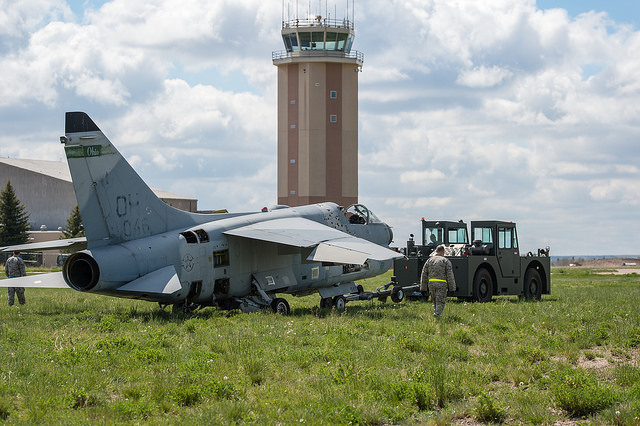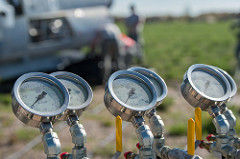Wyo. Air Guard aircraft maintainers practice recovering fighter aircraft

For immediate release
Wyo. Air Guard aircraft maintainers practice recovering fighter aircraft
CHEYENNE, Wyo. – An A-7 Corsair II aircraft streaks across the cloudy landscape. The pilot transmits a distress call to the tower to relay that his aircraft is heavily damaged. He manages a hard landing but his aircraft has lost all system power and veered off the taxiway into heavy mud. A scenario similar to this is what activates the 153rd Maintenance Group Crash Damage or Disabled Aircraft Recovery team.
Flying units, like the 153rd Airlift Wing, Wyoming Air National Guard, are required by the Air Force to maintain CDDAR capability. This is broken down into two phases – initial response and recovery.
The maintenance group CDDAR team is responsible for the latter – recovery – which includes coordinating efforts to move the damaged or disabled aircraft to a parking or storage area. The specialized team of maintainers is comprised of: fuel systems, avionics, hydraulic, structural, propulsion and electro-environmental specialists; aerospace ground equipment mechanics; and aircraft crew chiefs. Every year, the CDDAR team practices responding to damaged or disabled aircraft that have blown tires upon landing, veered off the runway, or crashed.
 “As a team, we really enjoy coming out here,” said Tech. Sgt. Stephen
“As a team, we really enjoy coming out here,” said Tech. Sgt. Stephen
Palso, 153rd CDDAR chief. “We have some new equipment and some additional equipment coming, so this year, we set up a scenario which we haven’t beenable to do in the past – a scenario that will let us use the new
equipment.”
Palso gathered the full CCDAR team for the exercise and briefed them of the situation. In order for the aircraft to be towed, the maintainers had to
stabilize the aircraft with a tether and make sure the structure and gears would allow air bag jacking. Several air bags were used for stability and to jack the front landing gear. Air manifolds were set up for the front and
rear of the aircraft and connected to individual air bags. After jacking the aircraft, team members installed steel planking to support the forward gears and towed the aircraft out of the mud.
“This was the first time for me doing recovery training. My job was to help set up air bags and operate the manifold,” said Senior Airman Dakota Difrancesco, 153rd Aircraft Maintenance Squadron crew chief. “My normal job always has some sort of data and you are going to follow the book. When a plane crashes or runs of the runway into mud, you don’t always respond in the same way.”
“The whole concept of CDDAR is based on teamwork,” said Maj. Carl Johansen, 153rd Maintenance Squadron commander. “I am proud of the team for their many months of planning and hard work. It took sourcing necessary equipment, completing formal CDDAR training, establishing a [memorandum of understanding] with other units within the region, and coordinating with multiple entities to execute an aircraft recovery scenario like this.”
All members of the CDDAR team are volunteers who have taken on the program responsibilities and challenges beyond their normal maintenance duties and responsibilities. They hone their specialized skills daily so they can respond to an emergency like the one presented in the scenario.
-30-
Photos available at:
https://www.flickr.com/photos/
Media contact:
Public Affairs Office: email ng.wy.wyarng.list.pao-
Deidre Forster 307-772-5253; cell 307- 631-4153; email
deidre.m.forster.nfg@mail.mil
Maj. Thomas Blackburn 307-772-5229; email thomas.w.blackburn.mil@mail.
Capt. Megan Hoffmann 307-772-5935; email megan.n.hoffmann.mil@mail.mil
Sgt. 1st Class James McGuire 307-772-5235; email
james.p.mcguire.mil@mail.mil



